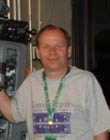 |
|
 Home Home
 Products Products
 Store Store
 Forum Forum
 Warehouse Warehouse
 Contact Us Contact Us

|
|
|
|
 
|
|
Author
|
Topic: Technicolor Donates Archives To Eastman House
|
Jim Cassedy
Phenomenal Film Handler

Posts: 1661
From: San Francisco, CA
Registered: Dec 2006
|
 posted 04-12-2010 09:52 AM
posted 04-12-2010 09:52 AM




Technicolor Donates Archives To Eastman House
Technicolor announced that it is donating its historic archive—dating from 1915 to 1974—to the George Eastman House International Museum of Photography and Film. The George Eastman House is the country’s third largest film archive and the world’s largest technology collection.
The announcement was made by Joe Berchtold, head of Technicolor’s creative Services division. “This commitment will ensure the history of Technicolor’s three-strip process–as well as two-color before it–will be preserved with full integrity,” he said. The corporate collection was put together by Dr. Richard Goldberg, who was the last head of the Technicolor Research Division and is known as one of the major color scientists in motion picture history. Goldberg, who has taught classes in color technology for Eastman House’s L. Jeffrey Selznick School of Film Preservation, worked with Eastman House to identify, clean and catalog the materials for acquisition and preservation.
Among the items in the archive are Technicolor camera blimps; VistaVision/Technirama magazine, camera and lens attachment; dye-transfer testing machine; 65mm matrix printer; 70mm Model C printer; Cinerama registering printer; spin pin belt machine; filters and plates used during the filming of Technicolor motion pictures; schematics of all the equipment illustrating how the machines were built; R&D spray processor designed for the dye-transfer process; and other items including Technicolor packing crates.
Technicolor was a trademark for a series of color film processes established almost a century ago, with the goal of bringing “natural” color to motion pictures. From 1927 to 1974, Technicolor films were the industry standard, with the years 1932 to 1955 known as the “Glorious Age of Technicolor,” featuring the three-strip dye transfer system.
“So many of the icononic films of the 20th century were photographed and presented in Technicolor,” said Dr. Anthony Bannon, the Ron and Donna Fielding Director of the George Eastman House. The museum’s existing Technicolor holdings include more than 3,000 reels of films as well as documents from Technicolor pioneers, such as founder Dr. Herbert Kalmus’ letters and notebooks detailing the earliest processes; the diaries of Leonard Troland, Technicolor chief engineer; and the papers and letters of Dr. John Andreas former head of Technicolor Research Department.
“I think Technicolor is to be commended for understanding that the crucial importance of preserving is archive,” said filmmaker Martin Scorsese. “I can think of no better location for this archive than George Eastman House, a leader in film and photography preservation. I’ve worked closely with them for a long time now, and they’ve always impressed me with their knowledge and passion. Eastman House is the perfect place for this historically invaluable collection from Technicolor.”
| IP: Logged
|
|
|
|
|
|
All times are Central (GMT -6:00)
|
|
Powered by Infopop Corporation
UBB.classicTM
6.3.1.2
The Film-Tech Forums are designed for various members related to the cinema industry to express their opinions, viewpoints and testimonials on various products, services and events based upon speculation, personal knowledge and factual information through use, therefore all views represented here allow no liability upon the publishers of this web site and the owners of said views assume no liability for any ill will resulting from these postings. The posts made here are for educational as well as entertainment purposes and as such anyone viewing this portion of the website must accept these views as statements of the author of that opinion
and agrees to release the authors from any and all liability.
|
|
|
|

 Home
Home
 Products
Products
 Store
Store
 Forum
Forum
 Warehouse
Warehouse
 Contact Us
Contact Us




 Printer-friendly view of this topic
Printer-friendly view of this topic









